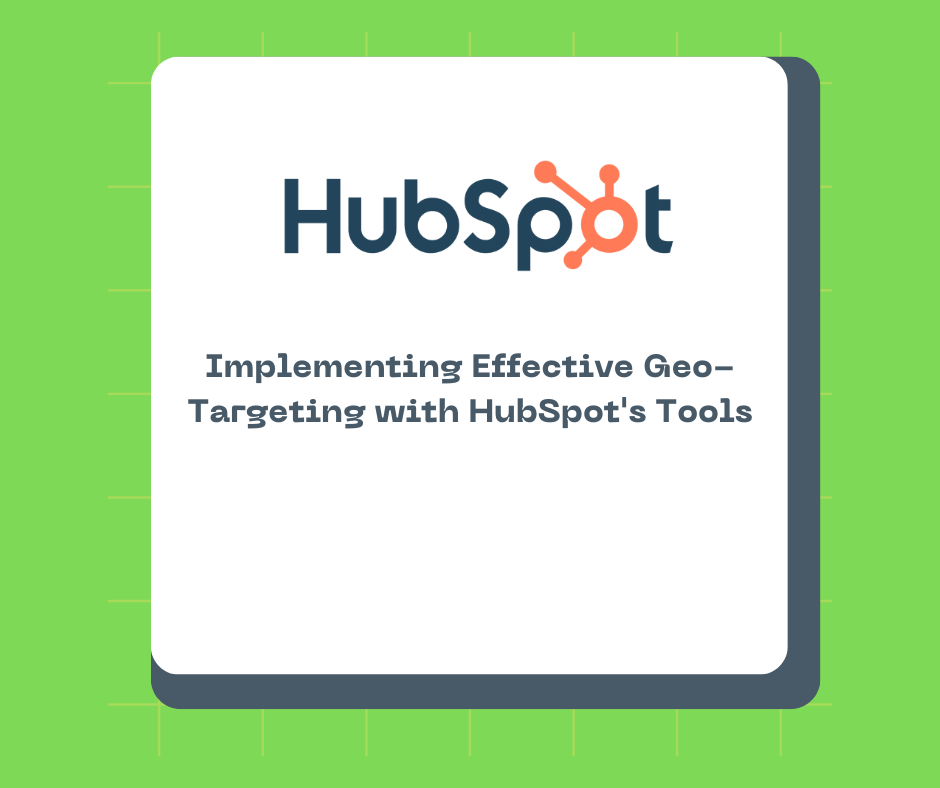Implementing effective geo-targeting strategies in your marketing campaigns can significantly enhance engagement, conversion rates, and customer satisfaction. HubSpot, with its comprehensive suite of tools, provides a robust platform for businesses looking to capitalize on the benefits of geo-targeting. This guide explores how to leverage HubSpot's tools to implement geo-targeting in your marketing efforts, ensuring that your messages reach the right audience, at the right place, and at the right time.
Understanding Geo-Targeting
Geo-targeting refers to the practice of delivering content or advertisements to a user based on their geographic location. This can range from broad targeting, such as country or region, down to more specific locales, like cities or ZIP codes. The aim is to create more personalized and relevant marketing experiences, leading to higher engagement and conversion rates.
The Benefits of Geo-Targeting in Marketing
- Increased Relevance: Content tailored to a user’s location is more likely to be relevant, improving engagement rates.
- Improved Customer Experience: Geo-targeting allows for personalized experiences, such as offering promotions specific to a user's locale, enhancing the overall customer journey.
- Higher Conversion Rates: By targeting users with content and offers that are applicable to their locale, businesses can see a significant increase in conversion rates.
- Efficient Ad Spend: Geo-targeting ensures that marketing budgets are spent on reaching the most relevant audiences, reducing waste on less interested segments.
Leveraging HubSpot for Geo-Targeting
1. Segmenting Your Contacts
The first step in implementing geo-targeting with HubSpot is to segment your contacts based on geographic data. HubSpot allows you to use contact properties such as country, city, or ZIP code to create targeted lists. This segmentation can be used to tailor email campaigns, content offers, and more, ensuring that your marketing efforts reach the intended audience.
2. Personalizing Content with Smart Content
HubSpot’s smart content feature enables you to customize website content based on the visitor’s location. This means you can show different images, offers, or calls to action based on where the user is browsing from, making your website dynamically adapt to each visitor's context. Implementing smart content requires setting up rules based on the geographic criteria of your segmented lists.
3. Localizing Email Marketing Campaigns
With the segmented lists based on geographic data, you can create email marketing campaigns that are highly tailored to different locales. HubSpot’s email tool allows you to personalize subject lines, content, and offers based on the recipient's location, increasing the relevance and effectiveness of your email marketing efforts.
4. Geo-Targeting in Social Media and Paid Advertising
HubSpot’s social media tools and integrations with platforms like Google Ads and Facebook Ads enable precise geo-targeting in your paid advertising and social media campaigns. You can create and manage campaigns directly from HubSpot, targeting specific geographic segments with tailored messages and offers, thereby maximizing the ROI of your advertising spend.
5. Analyzing Geo-Targeting Performance
To refine and improve your geo-targeting strategies, it's vital to analyze the performance of your campaigns. HubSpot provides detailed analytics and reporting tools that allow you to track the effectiveness of your geo-targeted marketing efforts. You can assess metrics such as engagement, click-through rates, and conversion rates by location, enabling you to identify what works best for different geographic segments.
Best Practices for Geo-Targeting with HubSpot
- Start with Accurate Data: Ensure your contact database is up-to-date with accurate geographic information. This might involve regular data cleaning and verification processes.
- Test and Learn: Use A/B testing to compare the performance of geo-targeted campaigns against more generic ones. This will help you understand the impact of your geo-targeting efforts.
- Keep Privacy in Mind: Always be mindful of privacy laws and regulations, such as GDPR, when collecting and using geographic data.
- Use Local Language and Currency: When targeting users in specific locations, consider localizing your content further by using the local language and currency to enhance relevance and user experience.
- Monitor and Adjust: Continuously monitor the performance of your geo-targeted campaigns and be ready to adjust your strategies based on what the data tells you.
Conclusion
Geo-targeting presents a significant opportunity for businesses to connect with their audience in a more meaningful and effective way. By leveraging HubSpot's comprehensive tools for segmentation, smart content, personalized email marketing, and detailed analytics, businesses can implement successful geo-targeting strategies that enhance engagement, improve customer experiences, and increase conversions. Remember, the key to successful geo-targeting lies in understanding your audience, providing relevant content, and continuously optimizing your strategies based on performance data. With HubSpot as your platform, the process becomes streamlined, allowing you to focus on creating marketing campaigns that resonate with your audience, no matter where they are.
Schedule your training session here and comment “Need Training” on the request form.

Comments